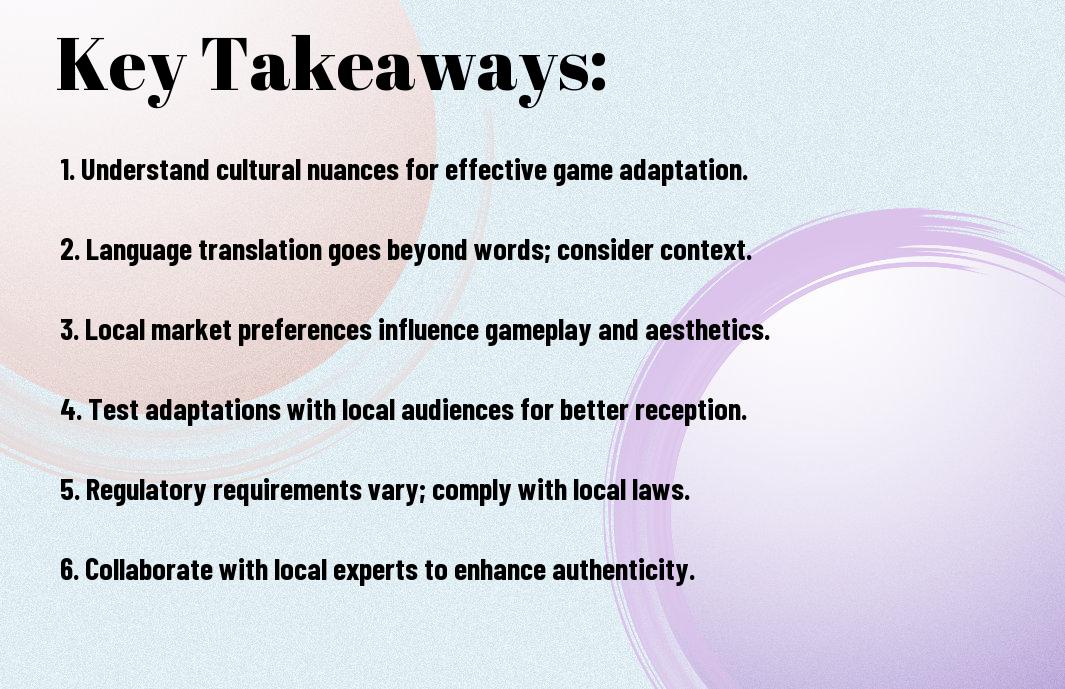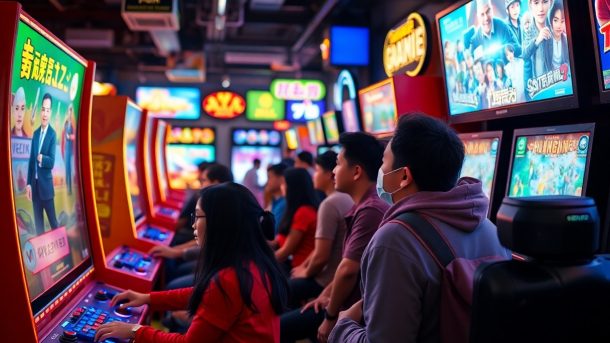As you venture into the global gaming market, you’ll encounter diverse cultures and languages that require adaptations to your game. You need to consider your target audience’s preferences, regulations, and technical requirements to ensure a successful launch. Your game’s success depends on how well you can tailor it to local markets, and this process is known as global localization. You will learn how to navigate these complexities and effectively adapt your game for international audiences.
Key Takeaways:
- Understanding the target audience is vital for successful game localization, as cultural differences and preferences can significantly impact player engagement and reception.
- Cultural adaptation is a key aspect of global localization, involving the modification of game content to accommodate regional norms, values, and sensitivities.
- Language translation is a fundamental component of game localization, requiring attention to nuance, context, and linguistic accuracy to ensure effective communication with diverse player bases.
- Technical considerations, such as character encoding and font support, must be addressed to ensure seamless gameplay and user experience across different regions and platforms.
- Market research and analysis are vital for identifying regional trends, player preferences, and competitor activity, informing localization strategies and optimizing game development.
- Collaboration between developers, publishers, and localization experts is necessary for effective global localization, facilitating the sharing of knowledge, expertise, and best practices.
- Continuous testing and feedback mechanisms are necessary to ensure that localized games meet player expectations and cultural standards, allowing for iterative improvement and refinement.
Cultural Adaptation Process
A thorough understanding of cultural nuances is imperative for successful game adaptation. You will need to consider various factors, including local regulations, consumer preferences, and cultural sensitivities, to ensure your game resonates with your target audience.
Language Translation Fundamentals
Against the backdrop of linguistic diversity, you must prioritize accurate translation to facilitate effective communication. You will need to adapt your game’s text, audio, and visual elements to cater to the language preferences of your target market.
Cultural Context Assessment
Any attempt to adapt your game for a new market requires a deep understanding of the local culture. You should conduct thorough research to identify cultural references, symbols, and values that may impact your game’s reception.
And as you examine deeper into cultural context assessment, you will discover that it involves analyzing the historical, social, and economic factors that shape the values and behaviors of your target audience. You will need to consider how these factors influence consumer preferences, gaming habits, and expectations, allowing you to make informed decisions about your game’s adaptation strategy.

Market Research Strategies
Any successful game localization effort begins with a thorough understanding of your target market, which involves gathering data on consumer behavior, preferences, and cultural nuances to inform your adaptation strategy.
Target Demographics Analysis
Among the key factors you will analyze are age, gender, and socioeconomic status, as these demographics often influence gaming habits and preferences, allowing you to tailor your game to meet the specific needs of your audience.
Regional Gaming Preferences
After identifying your target demographics, you will probe into regional gaming preferences, which can vary significantly from one market to another, requiring you to adapt your game’s content, mechanics, and overall user experience to resonate with local players.
Preferences for certain game genres, art styles, and storytelling approaches can differ greatly across regions, and understanding these differences is imperative to creating a localized version of your game that will appeal to your target audience, so you can make informed decisions about what elements to modify or retain to ensure your game’s success in diverse markets.
Technical Localization Elements
Unlike other aspects of game development, technical localization elements require a deep understanding of the target market’s infrastructure and preferences. You will need to consider various factors, including character encoding, data storage, and network connectivity, to ensure a seamless gaming experience for your players.
User Interface Modifications
Betwixt the lines of code and design, you will need to make adjustments to your game’s user interface to accommodate different languages and cultural norms. You should consider modifying font sizes, button layouts, and color schemes to ensure that your game is accessible and enjoyable for players from diverse backgrounds.
Regional Technical Standards
The technical standards and regulations of different regions can have a significant impact on your game’s performance and compatibility. You should be aware of the specific requirements for each market, including those related to data protection, online safety, and age ratings, to avoid any potential issues or delays.
Localization of technical elements is necessary to ensure that your game meets the regional technical standards. You will need to conduct thorough research and testing to guarantee that your game complies with the necessary regulations and is optimized for the local infrastructure. By doing so, you can provide your players with a high-quality gaming experience and increase your chances of success in the global market.
Content Modification
Despite the complexity of adapting games for diverse markets, you can successfully modify your content to suit different regions. This involves adjusting game elements, such as dialogue, graphics, and soundtracks, to cater to local tastes and preferences.
Cultural Sensitivity Review
Betwixt the lines of cultural differences, you must conduct a thorough review to ensure your game content is respectful and appropriate for your target audience, avoiding any elements that may be considered offensive or insensitive.
Regional Rating Systems
Culturally, you need to be aware of the varying rating systems in different regions, as these can impact your game’s content and distribution, and you should adapt your game to comply with these regulations to ensure a smooth release.
Modification of your game to meet regional rating systems is an vital step in the localization process, as you will need to adjust your content to conform to the specific guidelines and standards of each region, taking into account factors such as violence, language, and mature themes, to ensure that your game is accessible to your target audience and avoids any potential bans or restrictions.

Marketing Localization
For successful game localization, you need to consider the marketing aspect, which involves adapting your game to appeal to diverse markets, as discussed in Game Localization: Adapting Your Game for a Global Audience. This helps you reach a broader audience and increase your game’s popularity.
Regional Marketing Strategies
After understanding your target market, you can develop regional marketing strategies that cater to specific demographics, helping you tailor your approach to each region’s unique preferences and needs, allowing you to effectively promote your game.
Local Platform Selection
Any decision you make regarding local platform selection will significantly impact your game’s visibility and accessibility in different regions, so choose wisely to ensure your game reaches the intended audience.
At this stage, you should consider the most popular platforms in each region and optimize your game accordingly, taking into account factors such as payment methods, cultural preferences, and local regulations, which will help you navigate the complexities of global game distribution and increase your chances of success in diverse markets.
Quality Assurance
After adapting your game for diverse markets, you need to ensure it meets the required standards. You must conduct thorough testing to identify and fix bugs, cultural inconsistencies, and localization errors.
Regional Testing Protocols
Testing your game in different regions helps you understand local preferences and regulations. You can identify potential issues and make necessary adjustments to ensure a smooth gaming experience.
Local Player Feedback Integration
Regionally, you gather feedback from local players to improve your game’s overall quality and cultural relevance. You can use this feedback to make data-driven decisions and optimize your game for better player engagement.
Consequently, as you integrate local player feedback, you will be able to refine your game’s features, user interface, and overall gameplay. You will be able to identify areas that need improvement and make targeted changes to enhance the player experience, ultimately increasing your game’s popularity and success in diverse markets.
To wrap up
To wrap up, you now understand the significance of global localization in the gaming industry, and how it enables your games to thrive in diverse markets. By adapting your games to local cultures, you can increase your audience and boost your revenue. Your ability to navigate cultural nuances and tailor your content will set your games apart, allowing you to succeed in the global market and build a loyal player base worldwide.
FAQ
Q: What is Global Localization and why is it important for game development?
A: Global Localization refers to the process of adapting games to meet the cultural, linguistic, and regulatory requirements of diverse markets around the world. It involves more than just translating text and audio, as it also requires understanding the nuances of different cultures, adapting gameplay mechanics, and ensuring compliance with local laws and regulations. This process is important because it enables game developers to reach a broader audience, increase player engagement, and ultimately drive revenue growth. By localizing their games, developers can tap into the vast and diverse global gaming market, which is projected to continue growing in the coming years.
Q: What are some key considerations for game developers when adapting their games for global markets?
A: When adapting games for global markets, developers should consider several key factors, including cultural sensitivity, language support, and regional preferences. This includes researching local customs, traditions, and values to ensure that the game’s content is respectful and appropriate for each market. Additionally, developers should provide support for multiple languages, including subtitles, voiceovers, and text translations, to cater to diverse player bases. They should also be aware of regional preferences, such as different gameplay styles, genres, and platforms, to tailor their game to local tastes. Furthermore, developers must comply with local regulations, such as age ratings, data protection laws, and intellectual property rights, to avoid any potential issues or penalties.
Q: How can game developers ensure that their localized games are of high quality and meet the expectations of global players?
A: To ensure that their localized games meet the expectations of global players, developers should conduct thorough testing and quality assurance processes. This includes testing the game with local players, gathering feedback, and making necessary adjustments to the game’s content, mechanics, and performance. Developers should also work with local partners, such as translators, cultural consultants, and testing teams, to gain a deeper understanding of the local market and ensure that the game meets local standards. Moreover, developers should be prepared to make ongoing updates and patches to address player concerns, fix bugs, and add new content to keep the game fresh and engaging for players worldwide. By prioritizing quality and player satisfaction, developers can build a loyal player base and establish a strong reputation in the global gaming market.



